The 9th Primate Survey Method Training (MSP) event has just been completed ,were successfully held on 12-15 Deember 2022, in Sokokembang, and is the closing of Swaraowa’s activities in 2022. The primate survey method training activity, known as MSP, aims to increase capacity and encourage the emergence of primate researchers and conservationist from the younger generation, as well as building a network of primate researchers.
As in previous years, MSP 2022 is collaborating with KP3 Primata, Forestation Faculty of Forestry, Gadjah Mada University, who is longtime patner organizer, which is different from previous MSPs this year we are holding in December, and the MSP event course content is also more focused on the gibbon population estimate .
The series of events began with the announcement of registration to the selection of participants, where 25 applicants , we selected based on the motivation letters and CVs of each prospective participant, until finally 10 participants were selected. all these participants are fully funded for their transport, food and accomodation during in the field. This year’s participants are students who have or are currently doing primate research and are also non-governmental organizations.
The MSP 2022, with the concept of one day of basic theory in classroom and two practical days of data collection for the purpose of estimating primate populations presented by course tutor Salmah Widyastuti, a doctoral student from IPB who is also an alumni of MSP 2017, 2018. For the vocal count triangulation method this year too introduced the ASCR (Acoustic Spatial Capture-Recapture) analysis method for estimating gibbon density based on vocalization. The swaraOwa team itself had 2 speakers who provided material, namely Kurnia Ahmaddin who introduced the use of passive recording devices for monitoring based on sound, and Nur Aoliya who introduced bioacoustics analysis of the Javan gibbon calls.
There were two guest speakers that we invited to the MSP 2022 event, Dirk Meyer from Chance for Nature Germany, who also shared his experiences on using bioacoustics for the conservation of leaf-eating monkeys from the genus Presbytis and Indira Nurul Qomariah from the Center for Orangutan Protection who shared experience on cyber campaigns for the conservation of Indonesian primates.
Participants who were divided into 3 groups practiced the vocal count method for 2 days and also installed passive recording devices at predetermined observation points (Listening Points ). The practice of data collection and installation and data analysis was carried out on the second day, with the guidance of the presenters and guest speakers.
Presentation of research results and writing of reports on observations concluded the 4-day MSP 2022 activities in the Sokokembang forest. There is a selection of the best chosen based on the results of writing reports and presentations by participants.
The Sokokembang field course was held thanks to the support from Fortwayne Children’s Zoo, Ostrava Zoo, Chance for Nature, and Kopi Owa.
Written by : Arif Setiawan






